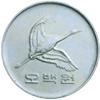Red-crowned crane facts for kids
Quick facts for kids Red-crowned crane |
|
|---|---|
 |
|
| Scientific classification | |
| Kingdom: | |
| Class: | |
| Order: | |
| Family: | |
| Genus: | |
| Binomial name | |
| Grus japonensis |
|
The red-crowned crane (Grus japonensis), also called the Japanese crane or Manchurian crane, is a large crane. It is the second rarest crane in the world after the North American whooping crane. In East Asia, it is known as a symbol of luck and fidelity. At 55 inches high, the crane does not make easy prey, for all that it stands out in its natural habitat of marshes and swamps. When it matures, the red-crowned crane is snow white with a patch of red skin on its head.
Contents
Description
In the spring and summer, the red-crowned crane lives in Siberia, where their eggs hatch. Normally the crane lays two eggs, but usually only one chick survives. Later, in the autumn, it migrates in flocks to Korea, Japan, China, Taiwan, and other countries in East Asia to spend the winter. All red-crowned cranes migrate, except for a flock that stays in Hokkaido, year long.
Diet
The crane eats small amphibians, aquatic invertebrates, insects, and plants that grow in marshes and swamps.
Images for kids
-
Grus japonensis (juvenile) in Ueno Zoo, Taitō, Japan
-
The official logo of Japan Airlines features a red-crowned crane.
-
One Hundred Famous Views of Edo, 1857 Hiroshige
-
Bronze sculptures of tortoise and crane in Wanshou Palace of Nanchang
-
The treasure box of the picture of picking red and releasing crane in Qianlong period of Qing Dynasty
See also
 In Spanish: Grulla de coronilla roja para niños
In Spanish: Grulla de coronilla roja para niños
















